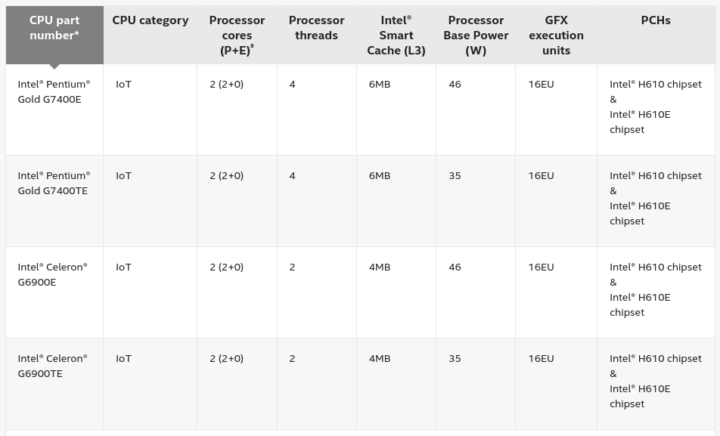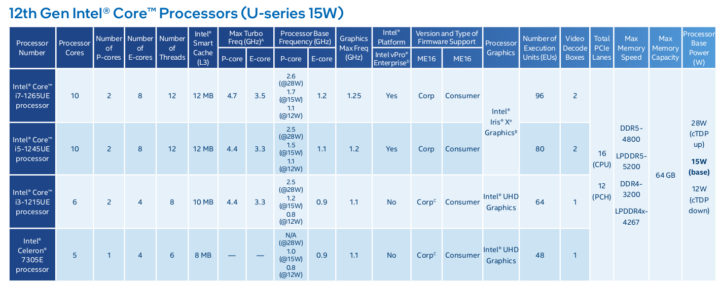Intel introduced high-end Alder Lake Hybrid processor family for consumer devices a couple of months ago, with Pentium G7400 and Celeron G6900 leaking a few weeks later, and now the company has formally announced the Alder Lake-S and Alder Lake-H processor families for respectively desktop IoT and mobile IoT solutions, as well as more efficient U-series and P-series of 12th Gen Intel Core Alder Lake IoT processors with a TDP ranging from 15W to 28W.
Alder Lake S-Series desktop processors for IoT
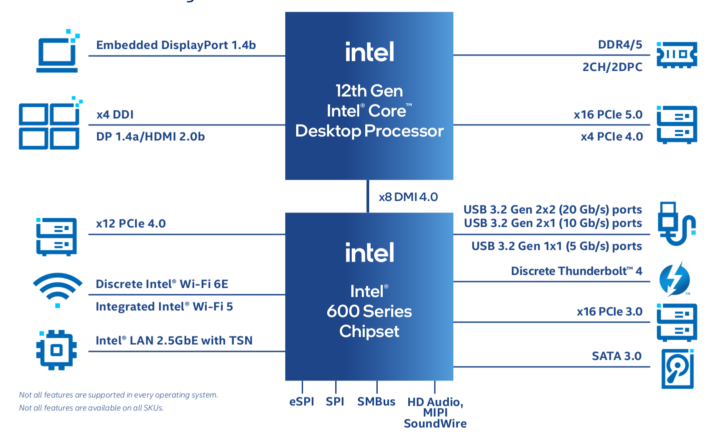 Key features and specifications:
Key features and specifications:
- CPU
- Up to 16 cores, up to 24 threads in IoT SKUs
- Up to 30 MB Intel Smart Cache
- TDP – 35W to 65W
- Real-time capability on select SKUs
- Graphics/Video
- Intel UHD Graphics 770 driven by Intel Xe architecture with up to 32 EUs
- Up to four independent displays up to 4K or one display at 8K resolution
- Up to two video decode boxes (VDboxes)
- AI Accelerators – Intel DL Boost with VNNI instructions on the CPU, int8/dp4 instructions on the GPU
- Memory – Up to 64GB DDR5-4800 or DDR4-3200 RAM
- Storage – SATA 3.0, PCIe
- Networking
- Discrete 2.5GbE LAN
- Integrated Intel Wi-Fi 5 (802.11ac) and support for discrete Intel Wi-Fi 6E with embedded-use conditions
- USB – Discrete Thunderbolt 4 or USB4, multiple USB 3.2 Gen 2×2 (20 Gbps), USB 3.2 Gen 2×1 (10 Gbps)
- PCIe
- Up to 16 lanes PCIe 5.0, up to four lanes PCIe 4.0 on the CPU
- Up to 12 lanes PCIe 4.0, up to 16 lanes PCIe 3.0 on the PCH
- Security and manageability
- Intel vPro platform eligible on select SKUs
- Intel Converged Security and Management Engine version 16
- LGA socket
- Intel 7 process technology
On the software side, the processors support Windows 10 IoT Enterprise 2021 LTSC, Yocto Project Linux, community-supported Celadon (Android) in VM, and Wind River VxWorks 7 operating systems, as well as KVM and ACRN hypervisors, plus UEFI and Slim Bootloader firmware.
There’s now a fairly long list of Core-i3 to Core-i9 from the Alder Lake Desktop family.
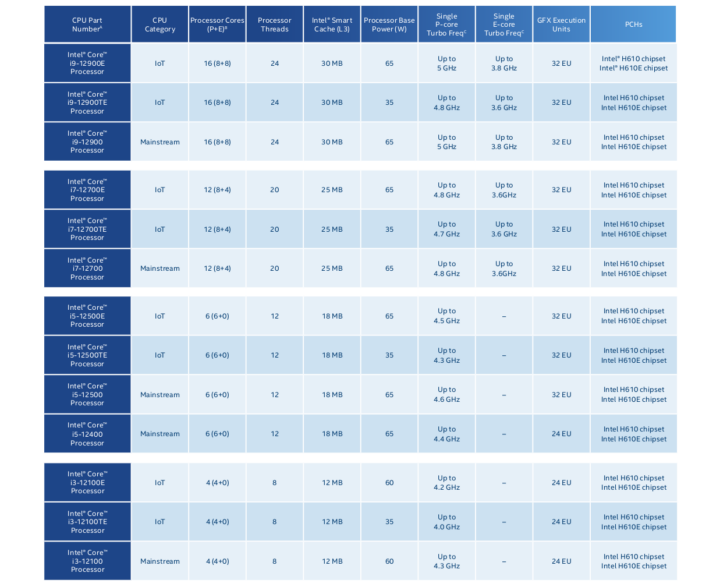
It should be noted on Core-i7 and Core-i9 parts are actual hybrid processors, with the Core-i3 and Core-i5 SKUs missing the efficient cores, which would provide less power saving due to the lower performance cores’ frequency and add to the costs. The table above taken from the product brief does not include the Pentium and Celeron part, but the product page does, and those are the embedded versions of leaked parts we mentioned in the introduction with Pentium G7400E/TE and Celeron G6900E/TE.
The Pentium parts are dual-core,four-thread processors, while the Celeron processor comes with two cores as well, but no multi-threading.
Intel says the Alder Lake S-Series processors deliver up to 1.36 times faster single-thread performance, up to 1.35 times faster multithreaded performance, up to 1.94x faster graphics performance, and up to 2.81x faster “in GPU image classification inference performance compared to equivalent 10th generation Intel Core processors.
Alder Lake H-series, U-Series, and P-Series IoT processors
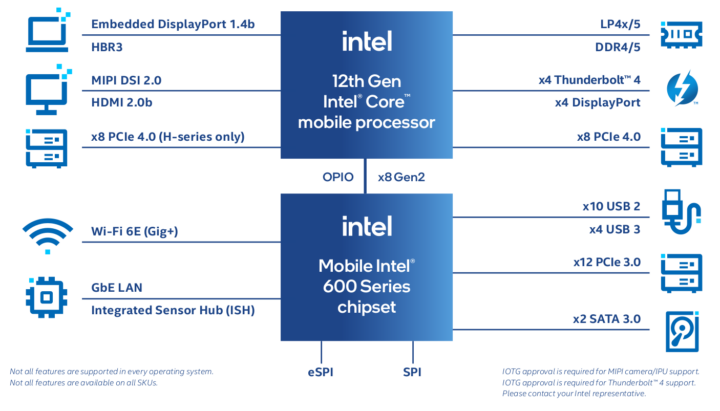 Key features and specifications:
Key features and specifications:
- CPU
- Up to 14 cores, up to 20 threads in IoT SKUs
- Up to 24 MB Intel Smart Cache
- TDP – 15W to 45W
- Graphics/Video
- Intel Xe graphics with up to 96 EUs
- HDMI 2.1 with LPSPON
- Up to four independent displays up to 4Kp60 HDR or one display at 8K resolution
- Up to two video decode boxes (VDboxes)
- AI Accelerators – Intel DL Boost with VNNI instructions on the CPU, DP4a instructions on the GPU
- Memory – Up to 64GB DDR5-4800, LP5-5200, DDR4-3200, LP4x-4267 RAM
- Storage – 2x SATA 3.0, PCIe
- Networking
- Integrated Gigabit Ethernet port, 2.5GbE discrete LAN
- Integrated Intel Wi-Fi 5 (802.11ac)/Bluetooth 5.1 (Wireless-AC 9560) and support for discrete Intel Wi-Fi 6E/Bluetooth 5.2 (AX210) with embedded-use conditions
- Intel 5G platform based on Intel’s host modem SW and M.2 module from Fibocom
- USB – Discrete Thunderbolt 4 or USB4, multiple USB 3.2 Gen 2×2 (20 Gbps), USB 3.2 Gen 2×1 (10 Gbps)
- PCIe
- Up to 16 lanes PCIe 4.0 on the CPU
- Up to 12 lanes PCIe 3.0 on the PCH
- Security and manageability
- Intel vPro platform eligible on select SKUs
- Intel Converged Security and Management Engine version 16
- BGA package
- Intel 7 process technology
Software support is the same as for the Alder Lake S-series desktop IoT processors, but we have more manageable lists of parts for all three H-Series, P-Series, and U-Series processors, and all of those are hybrid SoCs for Performance and Efficient cores.
The 15W Alder Lake U-Series may be quite interesting for single board computers and mini PCs providing those IoT SKUs are not too expensive. The Intel Celeron 7305E penta-core processor comes with one performance core @ 1.0 GHz, four efficient cores @ 0.9 GHz, as well as a 48EU Intel UDH graphics clocked at up to 1.1 GHz. No max turbo speeds are listed for the part, which I find odd, as a 1 GHz processor without turbo boost would be quite slow, even when taking into account architectural improvements.
Intel compares the Mobile IoT parts to equivalent 11th gen IoT processors with claims of 1.04x and 1.18x faster single-thread/multi-thread performance, and up to 2.29x faster graphics performance. So maybe we should not expect a massive performance increase over Tiger Lake processors, except for graphics. More details may be found on the product page.
The new Alder Lake IoT processor will be found in a wide range of products including retail PoS, digital signage, medical imaging equipment, computer-vision enhanced factory equipment, and network video recorders (NVRs) with built-in video analytics.

Jean-Luc started CNX Software in 2010 as a part-time endeavor, before quitting his job as a software engineering manager, and starting to write daily news, and reviews full time later in 2011.
Support CNX Software! Donate via cryptocurrencies, become a Patron on Patreon, or purchase goods on Amazon or Aliexpress


